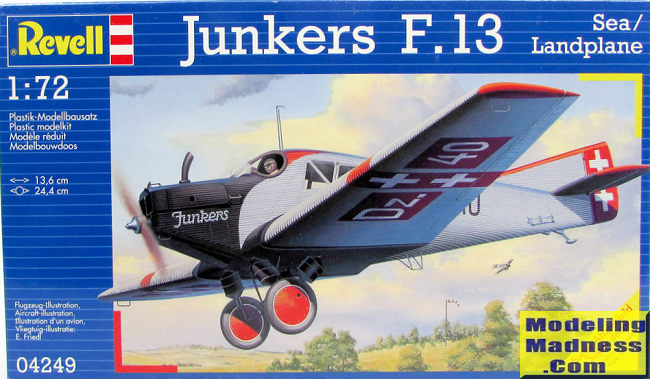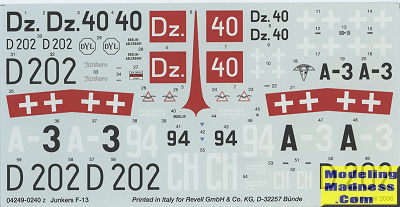
Revell 1/72 Junkers F.13
| KIT #: | 04249 |
| PRICE: | $16.98 'Used' |
| DECALS: | Four options |
| REVIEWER: | Scott Van Aken |
| NOTES: | 2006 tooling |

| HISTORY |
The Junkers F.13 (also known as the F 13) was the world's first all-metal transport aircraft, developed in Germany at the end of World War I. It was an advanced cantilever-wing monoplane, with enclosed accommodation for four passengers. Over 300 were sold. It was in production for thirteen years and in commercial service for almost twenty.
Any manufacturer of civil aircraft immediately after World War I was faced with competition from the very large numbers of surplus warplanes that might be cheaply converted – for example, the DH.9C. German manufacturers had further problems with the restrictions imposed by the Inter-Allied Aeronautical Commission of Control, which banned the production of warplanes and of any aircraft in the period of 1921–2. Junkers picked up orders abroad in 1919 in Austria, Poland and the USA and, in the following years with SCADTA (Colombia) and the United States Post Office Department. John Larsen Aircraft in the USA purchased a production license, their machines being designated JL-6. In 1922 there were sales in England, France Italy and Japan.
In Bolivia, LAB's first airplane was a Junkers F-13; first flight took off from Cochabamba on September 23, 1925.
Junkers set up its own airline – Junkers Luftverkehr AG in 1921 – to encourage the acquisition of the F.13 by German airlines which was flying 60 of them by 1923. They also established a branch of this airline in Iran. Other marketing techniques were used, providing F.13s on cheap leases and free loans, with such effect that some 16 operators across Europe were flying them. When Junkers Luftverkehr merged into Luft Hansa in 1926, 9.5 million miles had been flown by them. Luft Hansa itself bought 55 aircraft and in 1928 were using them on 43 domestic routes. Even in 1937, their F.13s were flying over 50 flights per week on four routes. They were finally withdrawn in 1938.
Most of the F.13s produced before completion of the marque in 1932 were built at Junkers German base at Dessau. During the difficult 1921–3 period production was transferred to Junkers plants at Danzig and Reval. In 1922–3, Hugo Junkers signed a contract with the Soviet Union to produce the aircraft in a Soviet factory at Fili near Moscow which became known as "Plant no. 22". Some of these aircraft served Soviet airlines and some the Red Army.
There were some other military users. The Colombian Air Force used the F.13 (and the related W.33, W.34 and K.43) as bombers in the Colombia–Peru War in 1932–3. The Republic of China flew F.13s converted into scout bombers until the January 28 Incident in 1932, when they were destroyed by the Japanese along with the Shanghai Aircraft Factory. The Turkish Flying Forces flew a few.
A feature that made the F.13 popular internationally was the ease with which its landing gear could be converted to floats. During the formative years of commercial aviation, bodies of water such as rivers, lakes, seas and oceans were more abundant than landing strips and civil airports in many parts of the world, so seaplanes were commonplace and even, in some places, more useful than regular aircraft. Aside from the obvious addition of floats, little modification was needed for this conversion; however, the different configuration could cause issues with directional control, and so some models had their rudder extended to compensate for this.
From their introduction in 1919, commercial F.13s were in service for more than thirty years; the last commercial F.13 was retired in Brazil in 1951.
A German-Swiss project to build a reconstruction of the F.13 was launched in 2009; the aircraft first lifted off in September 2016. The reconstruction is equipped with radio and a transponder, and uses a 1930s Pratt & Whitney R-985 Wasp Junior motor, but is otherwise as close as possible to the original. Additional reconstructions are to be sold for $2.5 million apiece.
| THE KIT |
 Revell's
kit comes on three basic grey sprues with one clear sprue for the windows.
Molding is excellent and the corrugations are properly subdued. I was pleased to
note that there were no sink areas on the corrogations, something I have noticed
on a few other similarly constructed models (like Monogram's Ford Tri-Motor).
Revell's
kit comes on three basic grey sprues with one clear sprue for the windows.
Molding is excellent and the corrugations are properly subdued. I was pleased to
note that there were no sink areas on the corrogations, something I have noticed
on a few other similarly constructed models (like Monogram's Ford Tri-Motor).
You are provided with a suitable four seat passenger compartment with a bulkhead between it and the cockpit. This latter section has two seats and a pair of control wheels, between which is an instrument panel. Since part of the engine sticks up out of the cowling, the upper cylinders and exhaust is provided to attach just forward of the cockpit. This is trapped between fuselage halves once you installed the windows from the inside. There is a separate upper fuselage section and lower forward cowling.
One has to decide to install either the floats or the wheels so as to determine which holes to open in the lower wings. Once that is done you can assemble the wings. Again, the decision to do land or floats will determine which rudder assembly to use and wheter to install the tail gear. At the front, the engine radiator can be installed once you attach the prop shaft and prop. The kit has a number of external hand holds and steps which Revell wants you to attach prior to the final steps, which is the assembly of either the floats or wheels. Not surprisingly, the floats are relatively complex with each float being four pieces and the various braces.
 Instructions
are well done with the usual 'Revell only' paint information though generic
equivalents are provided. All four options are unpainted metal with black engine
areas and most have large black sections on the wings, fuselage and/or
tailplanes. The most colorful is the box art plane of Lloyd Ostflug with lots of
red areas. Also with some red bits is the Swiss AD ASTARA Luftverkehrs AG plane
with red wing bands and upper fin. The other two are with the German Flight Test
Center in 1928 and with Austria's Osterreichische Lufterkehers AG in 1923.
Decals are nicely done and should present few issues.
Instructions
are well done with the usual 'Revell only' paint information though generic
equivalents are provided. All four options are unpainted metal with black engine
areas and most have large black sections on the wings, fuselage and/or
tailplanes. The most colorful is the box art plane of Lloyd Ostflug with lots of
red areas. Also with some red bits is the Swiss AD ASTARA Luftverkehrs AG plane
with red wing bands and upper fin. The other two are with the German Flight Test
Center in 1928 and with Austria's Osterreichische Lufterkehers AG in 1923.
Decals are nicely done and should present few issues.
| CONCLUSIONS |
I picked up this kit after reading a book on German civil aircraft in South America so will be looking for markings for various South American airlines. Most of the planes are little different aside from the large registration numbers so am hopeful that duplicating these will be possible as I doubt if there are any aftermarket sheets for this one.
| REFERENCES |
https://en.wikipedia.org/wiki/Junkers_F.13
January 2018 Copyright ModelingMadness.com.
All rights reserved. If you would like your product reviewed fairly and
fairly quickly, please
contact
the editor
or see other details in the
Note to
Contributors.
Back to the Main Page
Back to the Review
Index Page
Back to the Previews Index Page